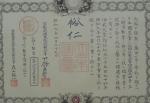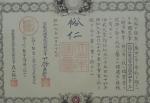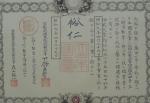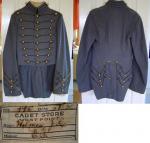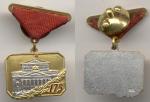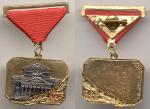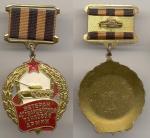-
Posts
2,123 -
Joined
-
Last visited
-
Days Won
4
Content Type
Profiles
Forums
Blogs
Gallery
Events
Store
Everything posted by Paul L Murphy
-

How to read Japanese certificates masterclass ! !
Paul L Murphy replied to Paul L Murphy's topic in Japan
Of note on this certificate is the fact that it is hand signed by the emperor, making it very scarce and desirable. The two large characters in the upper centre of the cert above the red square national seal are the emperors given name written in his own hand. So what does all of this say ? A full translation is as follows : - The Emperor of Japan who possesses heavenly guidance and is a descendant of the unbroken line of succession hereby confers upon Junior 4th Rank, 3rd Class Order of Merit, 5th Level of Bravery, Hirata Yukihiro the 2nd grade of the Meiji order and awards the order of the sacred treasure. He is entitled to the privileges and honourable treatment accorded to this rank. 2,594th year after the coronation of Emperor Jimmu, 29th April 9th year of Showa, the imperial seal is affixed in Tokyo Imperial Palace. Imperial Seal 29th April 9th year of Showa Shimojo Yasumaro, Junior 3rd rank and holder of the 1st order of merit. Director General, Bureau of merit & awards. Registered as number 867,289 and recorded in the medal roll. Moriyama ?ichi, 5th rank and holder of the 4th order of merit. Secretary, Bureau of merit & awards. -

How to read Japanese certificates masterclass ! !
Paul L Murphy replied to Paul L Murphy's topic in Japan
Another piece of information is the entry into the roll for the relevant award. This is a numerical roll in chronological order. The number of this certificate is 867,289 which is shown in the box indicated below. This means it was the 867,289th award of the Sacred Treasure in all classes since its inception. The Japanese count in units of ten thousand so this is actually written as 86 ten thousands, 7,289. -

How to read Japanese certificates masterclass ! !
Paul L Murphy replied to Paul L Murphy's topic in Japan
Now that we can find the date, we would like to know to whom it was awarded. This is a bit more trickey. On Meiji and Taisho order certificates you will find the military rank detailed before the name, on Showa certificates it is not. Basically the order of naming on Meiji and Taisho certs is : - Branch of service (army or navy), arm of service, military rank, noble rank (if any), level of previous orders awarded (of any), name. On Showa certificates you get : - Noble rank (if any), level of previous orders awarded (of any), name (family name first, then given name). In the case of this certificate it says "Junior 4th Rank, 3rd Class Order of Merit, 5th Level of Bravery, Hirata Yukihiro". Order of Merit is the classification for the Rising Sun or Sacred Treasure, Level of Bravery is the classification for the Golden Kite. Hence, we know that the recipient already holds a 5th class Golden Kite and a 3rd class Rising Sun or Sacred Treasure. The fact that he has a Golden Kite means we know it is a military recipient, otherwise from the naming alone we would not know if it was military or civil. -

How to read Japanese certificates masterclass ! !
Paul L Murphy replied to Paul L Murphy's topic in Japan
The date also appears calculated from the reign of Jimmu, the first Japanese emperor. Here the box outlines where it shows. It reads "From the reign of Emperor Jimmu year 2,594". An easy way to remember these dates is the fact that the 2,600th anniversary of the start of Jimmu's reign was in 1940, hence the commemorative medal issued that year. -

How to read Japanese certificates masterclass ! !
Paul L Murphy replied to Paul L Murphy's topic in Japan
Let us start off using a Showa period 2nd class Sacred Treasure certificate to point out the key information. Firstly you need to find the date under the reign of the awarding emperor. On this certificate the date appears in two places as outlined in boxes below. In this example it is Showa 9th Year, 4th month, 29th day. This places it as an award for the Manchurian Incident awarded in April 1934. -
I hope to expand this thread into a basic step by step guide to reading the basic information on Japanese award certificates since they are a fascinating subject. To start it off, one of the basic things to know is the period of the award, which can be broken down into Meiji, Taisho, Showa or Heisei. The years of each are detailed elsewhere. Most collectors will only encounter the first three, Heisei certs have not yet started to trickle onto the market in much quantity. The attachments below show the wording for Meiji, Taisho and Showa as they appear on certificates in that order from left to right. Apologies for the fact that the Taisho scan is larger than the others ! Meiji and Showa certificates are more common than Taisho due to the longer reigns and larger conflicts. Knowing which reign you are looking at is important since the numbers that follow will give the year within that reign and hence allow you to date the certificate. Russo Japanese War certificates are normally from April Meiji 39 and China Incident certificates are from April Showa 15. These are by far the most common award dates encountered.
-
Information on mint marks is hard to find since the Mint records are not available (destroyed in the war apparently). M is the normal Osaka mint mark but the dates it was used are variable. The t mintmark is believed to be of a private manufacturer. You find a lot of different private marks on Red Cross medals in particular since they were made by a variety of different private firms, as well as the mint. The mark on yours, like a t, is actually the Japanese character "hee". Most of the other marks found are also Japanese phoenetic characters but you do get the odd kanji (chinese character) here and there. Regards, Paul
-
One of the items in my collection is a West Point dress shako and tunic belonging to cadet J R Holmes and dated 1936. I believe that he served in The Philippines during WWII but would be grateful if anybody out there had more information on him. I have attached photos of the shako and tunic for those who are interested. Regards, Paul
-

Soviet Soviet Officers buckle
Paul L Murphy replied to Hauptmann's topic in USSR: Soviet: Other Militaria
At the moment from the dealers in the flea market in Moscow (apart from the rip off merchants) the buckle and belt (but no cross strap) is going for about US$60-80. There seems to be a high demand for these among local collectors as well. Might be time to start stockpiling a few ! -
I would agree with Ed. This is one piece that will live the rest of its life as an afterthought on a swopsie deal ! I doubt if you would find someone willing to pay cash for it so I think you probably got it fairly as an added bonus in your swap.
-
A rough guide to prices of cased Sacred Treasures, based on lowest prices between Japan and elsewhere, would be as follows : - 1st Class : $3,000 upwards 2nd Class : $1,400 - 2,000 3rd Class : $600 - 800 4th Class : $400 - 500 5th Class : $300 - 350 6th Class : $150 - 180 7th Class : $60 - 80 8th Class : $30 - 45 Meiji awards will tend to be more expensive. These are a very rough guide, especially at the upper end. Japanese orders tend to jump in price quite a bit once you go higher than 5th class. Still cheap compared to a lot of the Soviet items out there ! Best regards, Paul
-
The left hand medal is for the Manchurian Incident (1931-34) and the right hand medal is for the China Incident (1937-40).
-
I will do some more detailed threads on documents since they are one of my favourite aspects of collecting Japanese medals but for now I will give some of the basics about these specific certificates. Let's take the left side of the certificate first since it is more boring and easier to explain. The three lines of text that end in dark black characters (on these two certs these are the first, second and fifth line of text starting from left to right) are the titles, names and signatures of the head of the Bureau of Medals and Awards and the secretaries of the same bureau. Obviously depending on the time period the individuals and their honorary titles change but these lines do not provide us with much useful information. The other two lines of text on the left side of the certificate (the third and fourth line of text from the left) read "recorded in the order roll as award number xxxxxx". Basically this gives the number of the entry. There is a separate roll for each order, but not for the different classes within the order. They started at 1 and worked their way forward as one would expect. Apart from people like me who are interested in relative scarcity of different award periods this is not particularly useful. I told you the left hand side of the certificates were boring ! Now we move the the right hand side. The big red box in the middle is the National Seal and appears on all certificates. The text on the right hand side changes depending on the era of the award, there are about four main variations in the wording. It is basically to the effect that the emperor awards xxxxxx with the Meiji order of merit xxx class at xxx on this day of xxxx. There are lots of nice titles used for the emperor and I will go into them in more detail in other threads. The key information for collectors is the recipient, who is mentioned in the second line of text from the right. On Meiji and Taisho period certificates the name include any military rank and honorific titles. On Showa period military ranks are missing. The sixth line of text from the right shows the date of the award under the Imperial system starting with the reign of Jimmu (these are the numbers in the blue box). Basically 1940 was the 2,600th year of imperial reign. The seventh line of text from the right (numbers here in yellow box) give the year in the present emperors reign. On these certs it is Meiji. There is a pinned thread from Ed showing the years of the different emperors. I will post the Japanese names into this thread later. That is basically how a certificate is constructed. Now you all need to know what they actually say in detail ! I will start on that once I get home this evening. Hopefully by the time I am finished you will be as addicted to these as I am. Regards, Paul
-
Dan, This is the basic men's membership medal for the Japanese Red Cross. The case, however, is for the Special Membership Medal which would be the same medal only with a rosette in the ribbon colours on the ribbon. The reverse inscription on the case is the name of the company which manufactured it, which is itself unusual since most of these are found without such a manufacturer's name. If you have a copy of my book there is a chapter on Red Cross awards. The basic hierarchy is as follows : - Member's Medal (what you have) Special Member's Medal Life Member's Medal Special Member's Medal in Gold (instituted in the 1950's and only has gold highlights to the design. Always made from aluminium.) Honorary Member's Medal (almost never awarded, I have never seen one for sale) Silver Merit Cross Gold Merit Cross These came in both male and female versions. The only medals still awarded in medallic form are the Honorary Medal and the Gold Merit Cross. Regards, Paul
-
Dan, This is a 6th class award. It breaks my poor heart to see it like this From the size of the central mirror I would guess that this is a Meiji period award, the later awards have a larger mirror. The reverse inscription is common to all Orders of the Sacred Treasure and Rising Sun irrespective of the class and says Merit Medal. You are unlikely to find the missing part and sending it for repair in Japan would probably cost more than the price of a 6th class order in decent condition. These are pretty well made so it must have been subjected to a serious amount of abuse to break like this ! Regards, Paul
-

Soviet 4th Tank Army Veteran's Certificate
Paul L Murphy replied to Paul L Murphy's topic in USSR: Soviet: Other Militaria
Rick, I will keep a lookout for it here in Moscow. If I find it, it is yours. Regards, Paul -

Soviet 4th Tank Army Veteran's Certificate
Paul L Murphy replied to Paul L Murphy's topic in USSR: Soviet: Other Militaria
Finally I found the badge to go with the certificate. They make a lovely couple. I also got a badge for the 40th Anniversary of the 4th Guards Tank Army so I will probably put them together to disprove the idea that three is a crowd. -
The only change with this was dropping the two lowest grades and opening it up to women. The insignia are unchanged from before.
-
Unfortunately these certificates do not mention the unit. I am out of town on a business trip at the moment but once I get back I will do a thread on the documents, how to read them, what they contain etc.
-
Ed, It sounds equally horrible in Japanese. The entire reform of the Japanese award system was a half baked measure done by gnomes with no imagination whatsoever. I have not yet seen a new style Sacred Treasure for sale, I think it will be a while before they start to filter onto the collectors market. I am looking forward to handling one to see if the quality has stayed to the previous high standard. Regards, Paul
-

Soviet Hierarchy of Soviet Awards?
Paul L Murphy replied to Christian Zulus's topic in USSR: Soviet Orders, Medals & Decorations
Two of the veterans I spoke to on 9th May were more proud of their Medal for Bravery than their other decorations (and one of these old boys had four Red Stars and the other had a Glory 3rd Class !).


